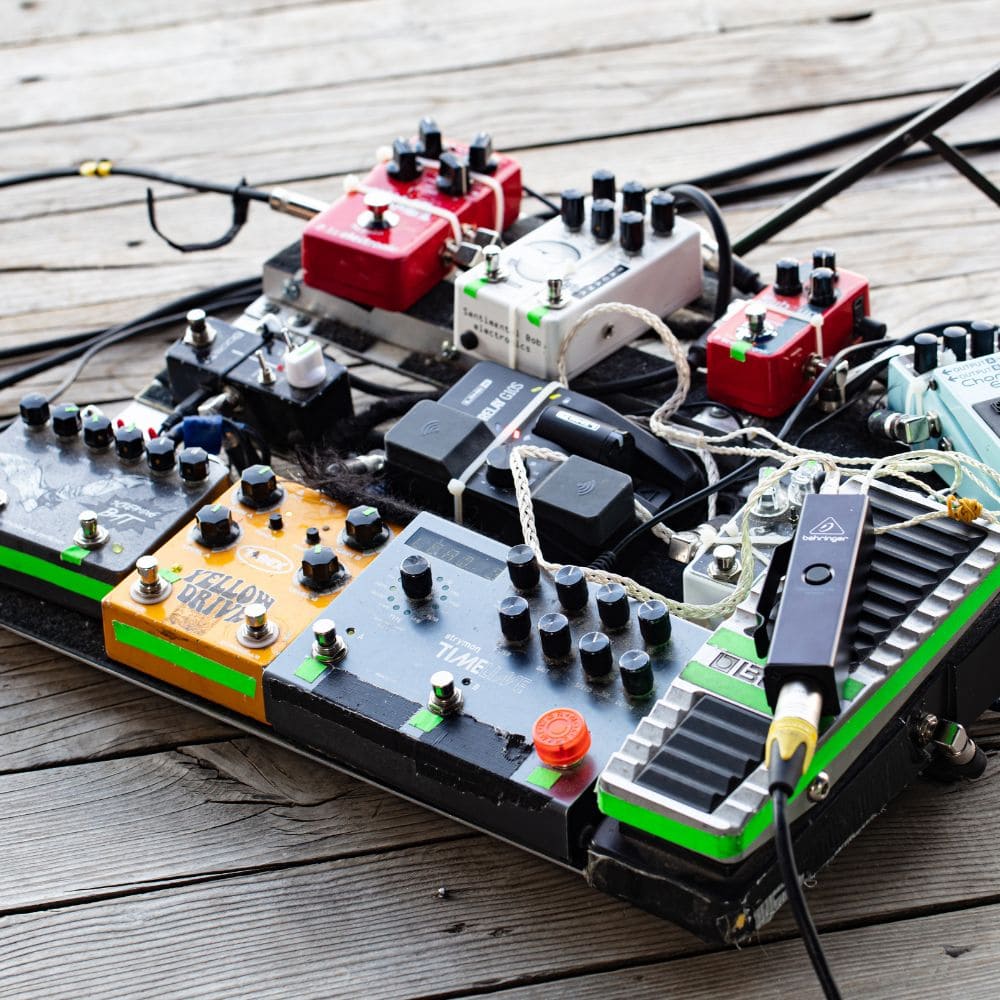What is the difference between envelope filter and wah?

When it comes to musical effects, guitarists and musicians often seek to experiment with various pedals to enhance their sound and create unique tones. Two popular pedals in this realm are the envelope filter and wah pedal.
In this article, we will delve into the differences between these two pedals, their unique functionalities, and their significance in music.
Answer to the Question
The envelope filter and wah pedal are both instrumental devices that modify the sound of an electric guitar. While they share similarities in altering the guitar's sound, they operate on different principles and produce distinct effects.
The envelope filter modulates the frequency of a guitar signal depending on the input dynamics, while the wah pedal alters the tone by manipulating the frequency spectrum with a rocking foot pedal.
These disparities form the crux of the difference between the two which we will further explore.
Understanding Envelope Filter and Wah Pedal
The envelope filter and the wah pedal are two distinct types of guitar effect pedals that have a significant impact on the instrument's sonic output.
The envelope filter, also known as an auto-wah, is a dynamic filter effect that responds to the volume and attack of the input signal, modifying the guitar's frequency content.
On the other hand, the wah pedal, short for wah-wah pedal, alters the tonal characteristics by shifting the peak response of a frequency filter back and forth using a foot pedal.
How Envelope Filter Works
The envelope filter, also known as an auto-wah, is an effect pedal that dynamically filters the tone of a musical instrument.
It works by analyzing the input signal's dynamics and adjusting the frequency response accordingly. When the amplitude of the input signal exceeds a certain threshold, the filter's cutoff frequency varies, producing a sweeping effect that follows the instrument's signal dynamics.
This dynamic modulation imparts a vocal-like quack to the sound, creating a distinctive and expressive effect. To understand how the envelope filter achieves these effects, let's delve into its internal workings and signal processing mechanisms.
- Internal Signal Analysis: The envelope filter constantly monitors the input signal's amplitude and adjusts the filter's characteristics in real-time. This analysis allows the pedal to precisely track the instrument's dynamics.
- Frequency Response Adjustment: As the input signal surpasses the designated threshold, the envelope filter dynamically alters its frequency response. This adjustment causes the filter to sweep through the spectrum, resulting in the characteristic wah-like effect.
- Expression and Articulation: By responding to the player's touch and technique, the envelope filter becomes a vehicle for expression and articulation. It captures the subtleties of the instrument's playing style and translates them into dynamic tonal changes.
- Effect Variations: The envelope filter offers various parameter controls, such as sensitivity, resonance, and range, which enable musicians to fine-tune the sweeping effect to their preference.
The envelope filter's rich sonic capabilities make it a versatile tool in genres like funk, disco, and experimental music. Its ability to transform the instrument's timbre with expressive quacks and dynamic sweeps has solidified its place as an essential effect in contemporary music production.
How Wah Pedal Works
In order to understand how a wah pedal works, it is essential to delve into its internal mechanisms and the physics behind its operation.
A wah pedal, also commonly referred to as a wah-wah pedal, is a signal processing device that modulates the tonal characteristics of an electric guitar's sound.
The core principle behind the functionality of a wah pedal lies in its employment of a bandpass filter, which allows a specific range of frequencies to pass through while attenuating frequencies outside this range.
At the heart of a wah pedal is a rocker pedal mechanism that enables the guitarist to control the position of the frequency peak within the bandpass filter. This manipulation leads to a dynamic alteration of the guitar signal's tonal emphasis, resulting in the distinctive 'wah' effect.
When the rocker pedal is moved forward and backward, it adjusts the center frequency of the filter, thereby creating the characteristic sweeping sound associated with the wah effect.
Furthermore, the wah pedal encompasses an arrangement of potentiometers and capacitors, which work in conjunction to modulate the signal passing through the bandpass filter. These components shape the frequency response of the filter and contribute to the expressive control offered by the wah pedal.
Additionally, the interaction between the foot-controlled pedal and the internal circuitry of the wah pedal allows for real-time manipulation of the guitar's tonal output, enabling musicians to infuse their performances with emotive and dynamic tonal shifts.
This capability has solidified the wah pedal as an iconic tool in the sonic arsenal of funk, rock, and blues musicians worldwide.
Comparison of Sound Effects
When comparing the sound effects produced by the envelope filter and the wah pedal, notable distinctions arise.
The envelope filter generates a dynamic and responsive modulation that adds a distinct vocal-like tone to the guitar's sound.
In contrast, the wah pedal delivers a sweeping and expressive alteration of the guitar's tonal qualities, allowing for rhythmic and emotive effects through manual manipulation.
Notable Features of Envelope Filter and Wah
- Different Sensitivity to Input: The envelope filter and wah pedal differ in their sensitivity to input dynamics. The envelope filter responds to subtle changes in playing intensity, creating a sweeping, auto-wah effect that is particularly suited for genres like funk, disco, and experimental music. On the other hand, the wah pedal's foot-controlled manipulation offers precise control over the guitar's tone, allowing players to expressively shape the sound of blues, rock, and jazz performances.
- Frequency Range and Resonance: When it comes to frequency range and resonance, the envelope filter and wah pedal display distinct characteristics. The envelope filter's adjustable frequency range and resonance settings provide flexibility in shaping the filter sweep, allowing for unique tonal textures and rhythmic patterns. In contrast, the wah pedal's resonance primarily depends on the physical construction and design, resulting in a narrower but pronounced sweeping effect that defines its classic sound.
- Expression Control: Both the envelope filter and wah pedal offer expressive control, albeit through different means. The envelope filter achieves expressiveness through its sensitivity to picking dynamics and its auto-wah effect, while the wah pedal embodies expressiveness through the manipulation of the pedal, allowing for seamless shifts in tone and articulation.
- Adaptability in Musical Contexts: While both effects have their distinctive character, they also showcase adaptability across various musical contexts. The envelope filter's dynamic response and sonic versatility make it suitable for genres that demand intricate rhythmic modulation and sonic exploration, from funk and disco to experimental electronic compositions. In contrast, the wah pedal's iconic expression lends itself to genres where emotive articulation and tonal shifts are paramount, such as blues, rock, and jazz.
Uses in Music
The envelope filter and the wah pedal have a rich history of diverse and captivating uses in music, spanning across a wide array of genres and musical styles.
Their versatile sound manipulation capabilities have made them indispensable tools for musicians, enhancing and sculpting the sonic landscapes of funk, disco, rock, blues, jazz, and experimental compositions with their unique and expressive characteristics.
Conclusion
In conclusion, the envelope filter and wah pedal epitomize the creative potential of guitar effects pedals, offering musicians unique ways to modulate and sculpt their instrument's sound.
While the envelope filter emphasizes dynamic response and auto-wah effects, the wah pedal's foot-controlled manipulation provides expressive tonal alterations.
Understanding the differences and applications of these pedals allows musicians to expand their sonic palette and explore new realms of musical expression. A quality wah or envelope filter pedal can open up a new world of sound.
*FYI, when you make a qualifying purchase through one of our links, we might receive a small commission from Amazon or other retailers, at no additional cost to you, which helps us to fund this site. It's a way to find what you're looking for while supporting us in the process!
